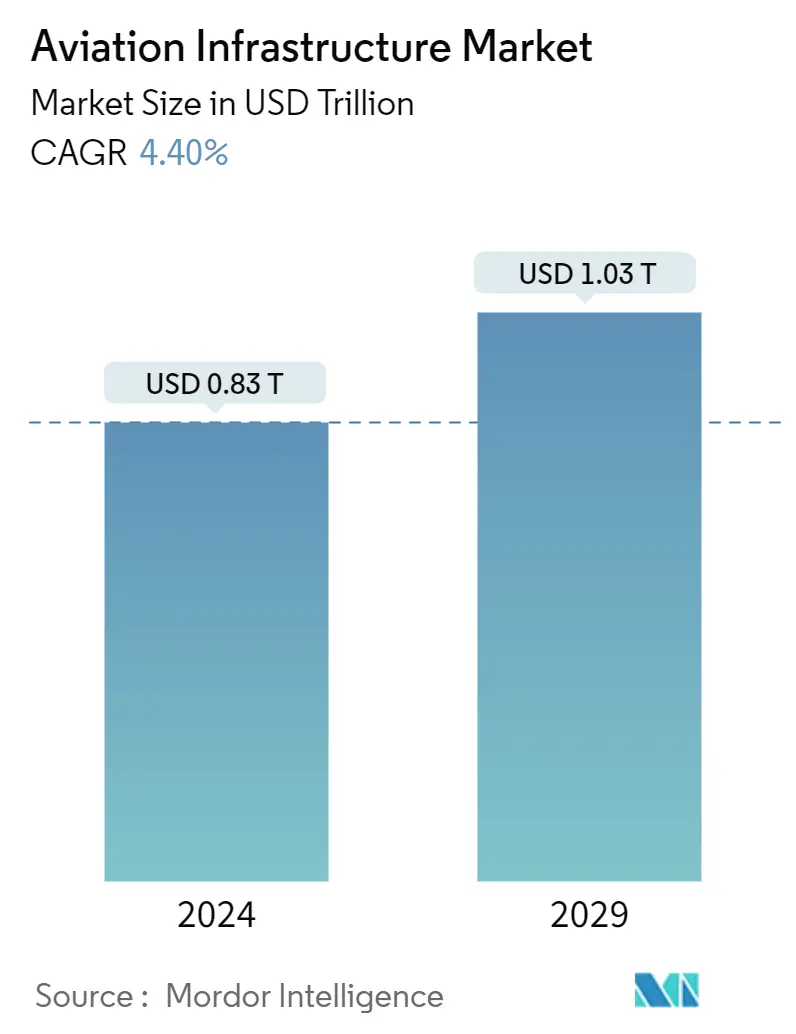Market Size of Aviation Infrastructure Industry

| Study Period | 2019 - 2029 |
| Market Size (2024) | USD 0.83 Trillion |
| Market Size (2029) | USD 1.03 Trillion |
| CAGR (2024 - 2029) | 4.40 % |
| Fastest Growing Market | Asia Pacific |
| Largest Market | Asia Pacific |
Major Players
*Disclaimer: Major Players sorted in no particular order |
Aviation Infrastructure Market Analysis
The Aviation Infrastructure Market size is estimated at USD 0.83 trillion in 2024, and is expected to reach USD 1.03 trillion by 2029, growing at a CAGR of 4.40% during the forecast period (2024-2029).
A significant growth in terms of commercial aircraft operations, number of air traffic passengers, and aviation infrastructure projects worldwide for meeting future aviation requirements are expected to lead to the growth of the market studied in the coming years. Various aviation authorities are anticipated to partner with established infrastructure companies due to growing commercial operations and increasing airport bottleneck issues. This is to ensure the development of sustainable airport infrastructure projects capable of handling future aviation requirements, thereby driving the market studied in the long run.
On the other hand, factors such as stringent regulations imposed by aviation authorities hamper the growth of the market studied. The growing usage of artificial intelligence as well as blockchain technologies is also expected to lead to increasing business opportunities for aviation infrastructure companies, thereby driving the market studied.
Aviation Infrastructure Industry Segmentation
Aviation infrastructure refers to all the groups of constructions, passenger terminals, landing strips, taxiways, platforms, parking spaces, internal access roads, equipment and installations, and civil works that are part of airports worldwide.
The aviation infrastructure market is segmented based on airport type, infrastructure type, and geography. The market is segmented by airport type into commercial, military, and general aviation airports. By infrastructure type, the market is segmented into terminal, control tower, taxiway and runway, apron, hangar, and other infrastructure types. Other infrastructure types include maintenance facilities and fire and rescue facilities. The report also covers the market sizes and forecasts for the aviation infrastructure market in major countries across different regions. For each segment, the market size is provided in terms of value (USD).
| Airport Type | |
| Commercial Airport | |
| Military Airport | |
| General Aviation Airport |
| Infrastructure Type | |
| Terminal | |
| Control Tower | |
| Taxiway and Runway | |
| Apron | |
| Hangar | |
| Other Infrastructure Types |
| Geography | |||||||
| |||||||
| |||||||
| |||||||
| |||||||
|
Aviation Infrastructure Market Size Summary
The aviation infrastructure market is poised for substantial growth over the forecast period, driven by an increase in commercial aircraft operations and air traffic passenger numbers. This growth is further supported by the expansion of aviation infrastructure projects worldwide, aimed at meeting future aviation demands. Partnerships between aviation authorities and established infrastructure companies are expected to enhance the development of sustainable airport projects, addressing airport bottleneck issues. However, the market's expansion is somewhat constrained by stringent regulations from aviation authorities. The integration of advanced technologies like artificial intelligence and blockchain is anticipated to create new business opportunities, further propelling market growth. The terminal segment, in particular, is expected to experience significant expansion due to the rising need for new airport terminal constructions to alleviate congestion and modernize facilities.
The Asia-Pacific region currently holds the largest market share and is expected to maintain its dominance, fueled by increased commercial aviation operations and growing air passenger traffic. The region has seen substantial investments in new aircraft and infrastructure projects to support the burgeoning aviation industry. Notable developments, such as the construction of new airports and terminal expansions, are set to drive market growth in the region. The aviation infrastructure market is characterized by fragmentation, with key players like Hensel Phelps, Skanska, and AECOM actively engaging in infrastructure projects and forming strategic partnerships with airport authorities. These companies are also focusing on integrating advanced technologies to meet the evolving needs of the aviation sector, which is expected to contribute to the market's growth trajectory during the forecast period.
Aviation Infrastructure Market Size - Table of Contents
-
1. MARKET DYNAMICS
-
1.1 Market Overview
-
1.2 Market Drivers
-
1.3 Market Restraints
-
1.4 Porter's Five Forces Analysis
-
1.4.1 Bargaining Power of Buyers/Consumers
-
1.4.2 Bargaining Power of Suppliers
-
1.4.3 Threat of New Entrants
-
1.4.4 Threat of Substitute Products
-
1.4.5 Intensity of Competitive Rivalry
-
-
-
2. MARKET SEGMENTATION
-
2.1 Airport Type
-
2.1.1 Commercial Airport
-
2.1.2 Military Airport
-
2.1.3 General Aviation Airport
-
-
2.2 Infrastructure Type
-
2.2.1 Terminal
-
2.2.2 Control Tower
-
2.2.3 Taxiway and Runway
-
2.2.4 Apron
-
2.2.5 Hangar
-
2.2.6 Other Infrastructure Types
-
-
2.3 Geography
-
2.3.1 North America
-
2.3.1.1 United States
-
2.3.1.2 Canada
-
-
2.3.2 Europe
-
2.3.2.1 United Kingdom
-
2.3.2.2 Germany
-
2.3.2.3 France
-
2.3.2.4 Rest of Europe
-
-
2.3.3 Asia-Pacific
-
2.3.3.1 China
-
2.3.3.2 India
-
2.3.3.3 Japan
-
2.3.3.4 South Korea
-
2.3.3.5 Rest of Asia-Pacific
-
-
2.3.4 Latin America
-
2.3.4.1 Brazil
-
2.3.4.2 Rest of Latin America
-
-
2.3.5 Middle East and Africa
-
2.3.5.1 United Arab Emirates
-
2.3.5.2 Saudi Arabia
-
2.3.5.3 Rest of Middle East and Africa
-
-
-
Aviation Infrastructure Market Size FAQs
How big is the Aviation Infrastructure Market?
The Aviation Infrastructure Market size is expected to reach USD 0.83 trillion in 2024 and grow at a CAGR of 4.40% to reach USD 1.03 trillion by 2029.
What is the current Aviation Infrastructure Market size?
In 2024, the Aviation Infrastructure Market size is expected to reach USD 0.83 trillion.

